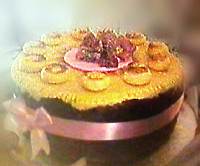Mothering Sunday

Mothering Sunday is a Christian festival celebrated throughout Europe on the fourth Sunday of Lent. Although in England it's often called 'Mothers' Day' it is not the same as the American (and Australian) celebration of Mothers' Day.
In the Roman religion the Hilaria festival was held in mid-March in honour of the mother goddess Cybele. As Europe converted to Christianity, this celebration became part of the church calendar as Laetare Sunday, the fourth Sunday in Lent, to honour the Virgin Mary and the "mother church". (Laetare means 'be joyful'.)
During the sixteenth century, people returned to their mother church for a service to be held on Laetare Sunday. This was either a large local church, or the nearest cathedral. Those who did this were said to have gone "a-mothering". In later times, Mothering Sunday became a day when domestic servants were given a day off to visit their mother church, usually with their own mothers and other family members. Later still, this became a day for children working as domestic servants or apprentices to have a day off to visit their mothers and families.
Prayer on Mothering Sunday
On Mothering Sunday, we give thanks for the refreshment of God's Spirit among us, God's love and the love of God's people. We give thanks for natural refreshment of food, drink and rest, for holidays and time off.
We give thanks and pray for mothers, families and households. We pray for single parents, those who cannot have children even though they wish to have them, and for single people.
We pray for a reduction in child labour and elimination of the enslavement of children as soldiers.
We give thanks and pray for our 'Mother' church, the St Saviour's Cathedral in Goulburn.
We give thanks that God is Mother and Father to all of us.
A day of refreshment

Mothering Sunday was also known as Refreshment Sunday because the fasting rules for Lent were relaxed that day.
Old and New Testament readings set by the 1662 Book of Common Prayer for mid-lent Sunday made a point of food. The Gospel reading from the New Testament told the story of how Jesus fed five thousand people with only five small barley loaves and two small fish (John 6:10-12).
The Book of Common Prayer epistle for the fourth Sunday in Lent honours maternal love: Galatians 4:26 declares that the "Jerusalem which is above is free; which is Mother of us all."
For some Church of England churches, it is the only day in Lent when marriages can be celebrated. Also in the Church of England, during services held in that day, it is traditional that children will give a bunch of spring flowers to their mothers.
Mothering Sunday Carol
by George Hare Leonard c. 1900; the carol portrays a way of life that no longer exists, but alludes to the origins of Mothering Sunday.|
It is the day of all the year, So I'll put on my Sunday coat, And now to fetch my wheaten cake Well have I known, as I went by |
My sister Jane is waiting-maid For mother'll come to church, you'll see — The boys will all come home from town It is the day of all the year, |
Simnel cake

Simnel cake celebrates the reuniting of families during the austerity of Lent. It is a light fruit cake covered in marzipan. A layer of marzipan or almond paste is also baked into the middle of the cake. On the top of the cake, around the edge, are eleven marzipan balls said to represent the true disciples of Jesus; Judas is omitted. In some variations Christ is also represented, by a ball placed at the centre. The cake is made from white flour, sugar, butter, eggs, fragrant spices, dried fruits, zest and candied peel.
Different towns had their own recipes and shapes of the Simnel cake. Bury, Devizes and Shrewsbury produced large numbers to their own recipes, but it is the Shrewsbury version that became most popular and well known.
The word "simnel" is medieval English, meaning a cake of fine flour, probably derived comes from the Latin word simila which means a fine wheat flour.
At the end of the service, each person receives a piece of simnel cake, symbolic of the richness of God's love, and the giving of strength to continue the Lenten road of discipline.
A recipe for Simnel cake
Ingredients
For the almond paste
250g caster sugar
250g ground almonds
2 free-range eggs, beaten
1 tsp almond essence
For the cake
175g butter
175g soft brown sugar
3 free-range eggs beaten
175g plain flour
Pinch salt
½-1 tsp ground mixed spice (e.g. mace, ginger, cinnamon)(optional)
350g mixed raisins, currants, sultanas
55g chopped mixed peel
½ lemon, grated zest only
1-2 tbsp apricot jam
1 free-range egg, beaten for glazing
Method
For the almond paste, place the sugar and ground almonds in a bowl. Add enough beaten egg and mix to a fairly soft consistency. Add the almond essence and knead for one minute until the paste is smooth and pliable.
Roll out a third of the almond paste to make a circle 18cm diameter and reserve the remainder for the cake topping.
Preheat oven to 140C. Grease and line a 18cm cake tin.
For the cake, cream the butter and sugar together until pale and fluffy. Gradually beat in the eggs until well incorporated and then sift in the flour, salt and mixed spice (if using) a little at a time. Finally, add the mixed dried fruit, peel and grated lemon zest and stir into the mixture.
Put half the mixture into a greased and lined 18cm cake tin. Smooth the top and cover with the circle of almond paste. Add the rest of the cake mixture and smooth the top leaving a slight dip in the centre to allow for the cake to rise. Bake in the preheated oven for 1¾ hours. Test by inserting a skewer in the middle — if it comes out clean, it is ready. Once baked, remove from the oven and set aside to cool on a wire rack.
Brush the top of the cooled cake with the apricot jam. Divide the remainder of the almond paste in half; roll out a circle to cover the top of the cake with one half and form 11 small balls with the other half.
Place the circle of paste on the jam glaze and set the balls round the edge. Brush the cake topping with a little beaten egg.
Preheat the grill to high. Place the cake onto a baking tray and grill for 1-2 minutes, or until the top of the marzipan begins to brown.